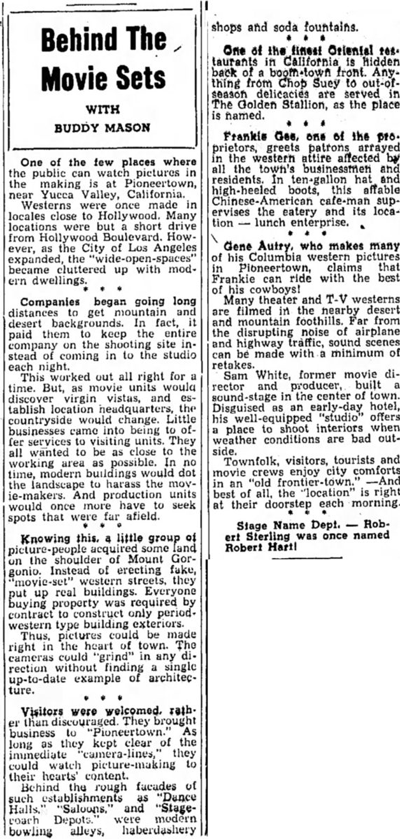Behind The Movie Sets
WITH BUDDY MASON
One of the few places where the public can watch pictures in the making is at Pioneertown, near Yucca Valley, California.
Westerns were once made in locales close to Hollywood. Many locations were but a short drive from Hollywood Boulevard. However, as the City of Los Angeles expanded, the “wide-open-spaces” became cluttered up with modern dwellings.
Companies began going long distances to get mountain and desert backgrounds. In fact, it paid them to keep the entire company on the shooting site instead of coming in to the studio each night.
This worked out all right for a time. But, as movie units would discover virgin vistas, and establish location headquarters, the countryside would change. Little businesses came into being to offer services to visiting units. They all wanted to be as close to the working area as possible. In no time, modern buildings would dot the landscape to harass the movie-makers. And production units would once more have to seek spots that were far afield.
Knowing this, a little group of picture-people acquired some land on the shoulder of Mount Gorgonio. Instead of erecting fake, “movie-set” western streets, they put up real buildings, everyone buying property was required by contract to construct only period-western type building exteriors.
Thus, pictures could be made right in the heart of town. The cameras could “grind” in any direction without finding a single up-to-date example of architecture.
Visitors were welcomed, rather than discouraged. They brought business to “Pioneertown.” As long as they kept clear of the immediate “camera-lines,” they could watch picture-making to their hearts’ content.
Behind the rough facades of such establishments as “Dance Halls,” “Saloons,” and “Stage-coach Depots.” were modern bowling alleys, haberdashery shops and soda fountains.
One of the finest Oriental restaurants in California is hidden back of a boom-town front. Anything from Chop Suey to out-of-season delicacies are served in The Golden Stallion, as the place is named.
Frankie Gee, one of the proprietors, greets patrons arrayed in the western attire affected by all the town’s businessmen and residents. In ten-gallon hat and high-heeled boots, this affable Chinese-American café-man supervises the eatery and its location – lunch enterprise.
Gene Autry, who makes many of his Columbia western pictures in Pioneertown, claims that can ride with the best of his cowboys!
Many theater and T-V westerns are filmed in the nearby desert and mountain foothills. Far from the disrupting noise of airplane and highway traffic, sound scenes can be made with a minimum of retakes.
Sam White, former movie director and producer, built a sound-stage in the center of town. Disguised as an early-day hotel, his well-equipped “studio” offers a place to shoot interiors when weather conditions are bad outside.
Townfolk, visitors, tourists, and movie crews enjoy city comforts in an “old frontier-town.” –And best of all, the “location” is right at their doorstep each morning.
Stage Name Dept.—Robert Sterling was once named Robert Hart!

